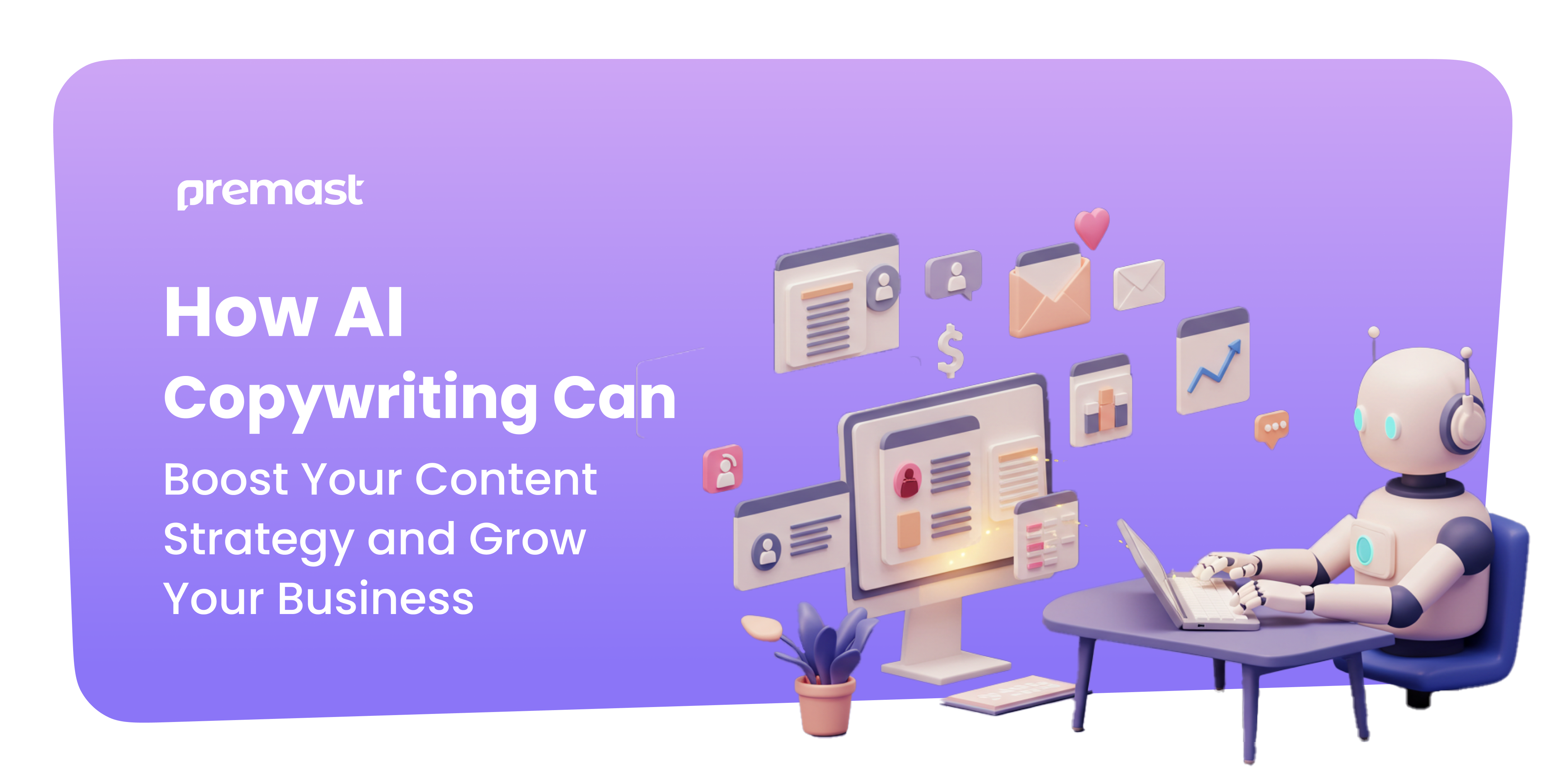Guides
How AI Copywriting Can Boost Your Content Strategy and Grow Your Business

AI copywriting is changing the way businesses create powerful, engaging content that gets real results. Across Northern Ireland, Ireland, and the UK, marketing managers and business owners are seeing how AI copywriting makes it easier to scale content production without losing quality or impact.
By using AI tools in your marketing, you can create more content in less time, keep your brand messaging consistent, and boost your return on investment. When used strategically, AI in copywriting doesn’t just save time; it helps transform your content marketing, strengthen your brand voice, and accelerate business growth.
What is AI in Copywriting?
AI in copywriting means using artificial intelligence tools to write content for marketing, advertising, and business communication. With the help of natural language processing (NLP) and machine learning, these tools generate text that feels human and is tailored to specific business goals.
Today’s AI copywriting software can create all kinds of content, from email campaigns, social media posts, and website copy to product descriptions and blog articles. By analyzing details like your target audience, brand voice, and content objectives, AI helps deliver engaging copy that resonates with readers while staying true to your business message.
The best part? AI has become advanced enough that companies can scale their content production without losing their unique brand voice. This is especially valuable for small and medium-sized businesses, giving them the ability to produce consistent, high-quality content without the heavy cost of large marketing teams.
Key Benefits of AI Copywriting
One of the biggest benefits of using AI in copywriting is speed. What once took hours to write can now be created in just minutes. This means marketing teams can spend less time drafting content and more time focusing on strategy, campaign optimization, and creative ideas.
Another major advantage is cost efficiency. By adopting AI tools, businesses can generate more content without needing to expand their teams. Instead, employees can use their creativity where it matters most, like audience research, campaign strategy, and performance analysis.
AI also ensures brand consistency. When aligned with brand guidelines, AI copywriting tools produce messaging that stays on-brand across websites, emails, ads, and social media. This helps businesses build stronger brand recognition while maintaining a professional voice at every customer touchpoint.
Finally, AI makes personalization at scale possible. Instead of writing each variation manually, businesses can use AI to create tailored messages for different customer segments, locations, or stages of the buyer journey. This leads to more relevant, engaging content, without extra production time.
AI- Copywriting Supports Every Area of Business
AI is transforming the way businesses create and share content, and one of the best examples is email marketing. With AI-powered tools, you can craft eye-catching subject lines, personalized email content, and persuasive calls-to-action that boost engagement and conversions. Plus, AI makes A/B testing faster and more effective by generating multiple variations in seconds.
When it comes to social media content creation, AI is a game-changer. Managing multiple platforms can be overwhelming, but AI helps by tailoring core messages to each channel while keeping your brand voice consistent and ensuring content resonates with platform-specific audiences.
For e-commerce businesses, AI copywriting is especially valuable. From product descriptions to category pages, AI can create compelling, benefit-driven copy that highlights features, answers customer questions, and maintains a consistent tone across large product catalogs, all while saving time and effort.
AI also plays a big role in long-form content like blog posts and articles. While human expertise is still key for strategy and unique insights, AI can generate solid first drafts that give writers a strong foundation to build on, making the content creation process faster, smoother, and more efficient.
Best Practices for AI Implementation
Getting the best results from AI in copywriting starts with creating clear brand voice guidelines. This should include your tone of voice, core messaging pillars, and real content examples. These act as a roadmap for AI, helping it produce consistent, on-brand copy across all your marketing channels.
Another key step is mastering prompt engineering. The way you write prompts directly impacts the quality of AI-generated content. Marketing teams should be specific, including details about the target audience, desired outcomes, content format, and messaging rules. Clear prompts lead to content that feels relevant, personalized, and aligned with your brand.
Even with powerful AI tools, human oversight is still essential. A strong quality assurance process ensures accuracy, brand consistency, and compliance. Every piece of AI-generated copy should be fact-checked, legally reviewed if needed, and aligned with your current marketing goals before publishing.
Finally, smart AI integration planning helps businesses unlock the real benefits. Instead of replacing entire workflows at once, start by using AI where it adds the most value, like generating first drafts, creating headlines, or offering variations of ad copy. This approach boosts productivity while keeping creativity and strategy in human hands.
Ways to Overcome AI Challenges
When businesses first explore AI in copywriting, concerns about content authenticity often come up. Readers can usually tell when writing feels too robotic, missing personality, or real insights. A smart approach is to let AI handle the first draft while human editors refine it with unique perspectives, industry expertise, and brand personality before publishing.
One of the biggest challenges is over-reliance on AI. While these tools are powerful, they can’t replace human understanding of customer needs, market trends, or business goals. The best results come from balancing AI efficiency with human creativity, strategy, and quality control. Another common issue is brand voice consistency. If multiple team members use AI with different prompt styles, the tone and quality of content can vary. To avoid this, businesses should create clear prompt templates and approval processes, ensuring content stays on-brand no matter who’s writing.
Finally, some companies face technical integration hurdles when adopting AI. The solution is to choose tools with strong API connections and work with digital marketing specialists who understand both the tech setup and the strategy behind it.
Best AI Tools
AI content generation platforms come in many shapes and sizes, each designed with different copywriting capabilities and audiences in mind. Larger enterprise solutions usually offer robust features like brand voice customization, team collaboration tools, and easy integration with your existing marketing tech stack, perfect for businesses that need an all-in-one solution.
On the other hand, specialized AI writing tools are built to excel at specific types of content, such as email campaigns, social media posts, or long-form blog articles. These platforms focus on deeper functionality for their niche, making them a great fit for teams with very specific content goals. Regarding pricing for AI copywriting tools, the right choice often depends on your content volume, team size, and must-have features. Many platforms use flexible tiered pricing, so you can start small with core features and scale up as your content needs grow.
Don’t overlook integration capabilities. If your business already uses content management systems, email marketing tools, or social media schedulers, choosing an integrated AI platform will save you time, reduce manual tasks, and keep your workflows running smoothly.
How to Measure AI Success
When using AI in copywriting, it’s important to track performance to see how well your content is working. Metrics like engagement rates, conversions, and audience feedback give clear insights into which AI-generated content performs best and where a human touch may still be needed.
Save Time with AI-Powered Content Creation
One of the biggest advantages of AI in copywriting is time savings. By comparing how long it takes to produce content before and after using AI tools, businesses can see just how much faster they can generate, edit, and publish quality content. This helps teams measure true efficiency gains.
Understand the Cost and ROI of AI Tools
To get the full picture, it’s essential to analyze the costs of AI adoption. This includes subscription fees, training time, and how team roles may shift with automation. Weighing these against the time and output benefits helps calculate the real return on investment (ROI).
Keep Content Quality High with Regular Checks
Scaling content with AI doesn’t mean sacrificing quality. Regular reviews and audits of AI-generated content ensure that messaging stays accurate, engaging, and on-brand. By refining prompts and adding human oversight where needed, businesses can keep quality standards high while enjoying the efficiency of AI.
ROI and Business Impact
Using AI in copywriting can make a big difference to your bottom line. Companies that adopt AI tools often see results fast, like producing more content in less time, boosting conversion rates, and cutting content creation costs. Many businesses report saving 30–50% of their content production time within the first three months.
But the benefits go beyond just saving time. With AI, marketing teams can test multiple content variations, personalize messages for different audience segments, and keep a consistent brand voice across every channel. This leads to stronger campaigns, higher engagement, and better customer experiences.
As your business grows, so do your content needs. That’s where AI truly shines. Unlike traditional methods, AI copywriting tools can easily scale to handle more content without requiring the same level of extra resources, making growth more sustainable and cost-effective.
And here’s the real competitive edge: businesses that embrace AI copywriting early often pull ahead of their competitors. With the ability to create more content, personalize at scale, and adapt quickly, early adopters can capture market share while others are still catching up.
Impact of AI Technology
AI copywriting tools are becoming smarter every day, making it easier to create highly personalised content. These advanced systems can now tailor messages to individual customer preferences, past purchases, and engagement patterns—helping brands deliver more relevant and impactful communication without adding extra complexity to the process.
At the same time, AI is integrating more deeply with marketing automation platforms. Future solutions will connect seamlessly with CRM systems, email marketing tools, and social media platforms, giving businesses smooth, end-to-end workflows for content creation and distribution.
Another exciting trend is the rise of industry-specific AI copywriting tools. Designed for sectors like healthcare, finance, and professional services, these solutions understand specialised terminology, compliance rules, and audience needs—making them far more effective at reaching the right people with the right message.
AI is also evolving with real-time optimisation features. This means copywriting tools can now automatically adjust content based on live performance data and audience feedback. For marketers, that translates into more agile and responsive content strategies that adapt quickly to changing customer expectations and market conditions.
Ethics and Best Practices
Being open about using AI in copywriting builds trust with your audience and helps businesses stay compliant with regulations. Even though disclosure rules vary depending on location and content type, many companies now choose to be upfront about when AI tools are involved in creating content.
While AI can speed up content production, quality must never be compromised. Human oversight is still key to ensuring accuracy, brand consistency, and messaging that truly connects with your target audience.
Data privacy is another crucial factor when using AI-powered copywriting tools. If customer information is being processed for personalization, businesses need to fully understand how their chosen platforms handle and protect data to stay compliant.
Finally, originality remains essential. AI should be used as a helpful assistant, not a replacement for unique insights, creative ideas, and industry expertise. Blending AI efficiency with human creativity is what sets businesses apart and makes content truly engaging.
Guide to Using AI for Copywriting
Before diving into AI copywriting, it’s important to understand your current content needs. Start by reviewing your existing content creation process, look for bottlenecks, resource gaps, and areas where AI could make the biggest impact. This step ensures you’re building on a strong foundation and focusing AI where it delivers the most value.
Getting Your Team AI-Ready
Your marketing team is the key to success. Provide training on how to use AI copywriting tools, from writing effective prompts to applying quality checks. Encourage hands-on practice with chosen platforms and create clear guidelines for reviewing and approving AI-generated content. This preparation makes the transition smooth and boosts team confidence.
Start Small with Pilot Projects
Not every content type is the right fit for AI at first. Begin with low-risk projects such as email newsletters, social media captions, or blog posts. These are perfect testing grounds to see how AI performs before rolling it out to more critical or complex marketing materials.
Scale Gradually for Long-Term Success
As your team gains experience, you can gradually expand AI’s role in your content strategy. Scaling step by step helps maintain quality while giving your team time to refine processes and build expertise. This way, AI becomes a natural extension of your content workflow rather than a sudden disruption.
Frequently Asked Questions
How effective is AI copywriting for small businesses?
AI copywriting is a game-changer for small businesses. It helps you create high-quality, professional content without needing a big marketing team. Many businesses see content creation time drop by 40–60%, freeing up more time to focus on growth.
Is there a learning curve for AI copywriting tools?
Getting started with AI copywriting tools is easier than you might think. Most businesses feel comfortable within 2–4 weeks, and you can start using the basics right away. With regular use, you’ll naturally pick up more advanced features and strategies.
Can AI copywriting keep our brand voice consistent?
Absolutely. When you set clear brand guidelines and use well-structured prompts, AI copywriting tools can deliver content that consistently reflects your unique voice across blogs, social media, emails, and more.
What types of content does AI copywriting work best for?
AI shines when it comes to email marketing, social media updates, product descriptions, and blog posts. The best results happen when you combine AI’s speed with a human touch, guiding strategy and polishing the final content.
How do you measure success with AI copywriting?
You can track success by looking at time saved, the amount of content produced, audience engagement, conversion rates, and the overall ROI from your content marketing efforts. AI copywriting not only makes content creation faster but also helps drive real business results.
Let’s visit Premast to download free PowerPoint templates. You can also visit Premast Blog to keep up-to-date with new templates and get design tips from our PowerPoint experts!
Leave a Reply
You must be logged in to post a comment.









Leave a Reply
You must be logged in to post a comment.